West Virginia University
in Vendée, France

In the classroom by the sea... And at one
student's "home"
June 15, 1998
Today's session begins with a discussion of our weekend in France. Some have
gone south to Biarritz, some north to Nantes, and many have stayed in Les Sables. In
all cases, the weather was cooler and wetter than usual, but not completely
unpleasant. We also took a few minutes to go over the headlines in France since our
last meeting. Number one in the pages this Monday is the death of Eric Tabarly,
France's most famous sailor (ahead of Jacques Cousteau, in the hearts of many), who fell
overboard off the coast of Ireland Saturday morning and whose body is now considered by
most lost at sea. French sailors, however, will continue the search... On
another sports note, France's first showing in the World Cup was admirable -- a maserful
victory of 3-0 over South Africa. The darker side of European soccer has also shown
its face, as English houligans have ravaged the city of Marseille all weekend. All
of France has also followed in utter incomprehension the murder by apparent KKK
sympathizers of the black hitchhiker in Texas.

Today's more formal lecture centers on the politcal climate of France in the
19th century, a time when the country tottered between its future as an absoltue monarchy,
a constitutional monarchy, a Bonapartist Imperial dynasty, or a republican form of
democracy. One of our visits tomorrow will focus on the career of Georges
Clemenceau, a figure of capital importance in leading the nation toward republicanism and
tolerance. Clemenceau was also a major force in the exhonoration of the falsely
condemned Captain Dreyfus (publishing Emile Zola's famous "J'accuse" article of
1898), and also in leading France to victory in World War I.
Our second visit tomorrow will be to the prehistoric and magalithic
stone structures in the nearby countryside. Below some of our students review
the words of one of the top songs on the French hit parade in the summer of 1998 -- a song
the recounts a battle of the Celtic natives that takes place amone these very stone
structures. Irony... the song, "La Tribu de Dana" by Manau (Polydor,
1998), is based at once on an ancient Celtic melody and on the rap rhythms of modern
American inspiration. A perfect blend of two powerful oral traditions.
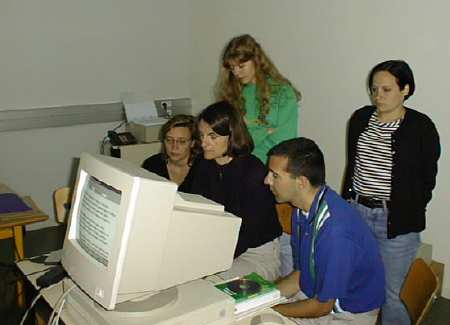
In the afternoon, Jennifer Campbell (right above) will return to her host family
in the home of Antoine Crêtaux (brother of Madame Lastinger) where she will meet some
fascinating relatives of the Crêtaux family. Dr. Lastinger's godfather, Dr. Paul
Lemoine, his wife, Madame Josette Lemoine, and Dr. Lemoine's sister, Sister Gabriel-Marie
Lemoine (known in the family as "Tante Yvonne") arrive in Antoine's home below.
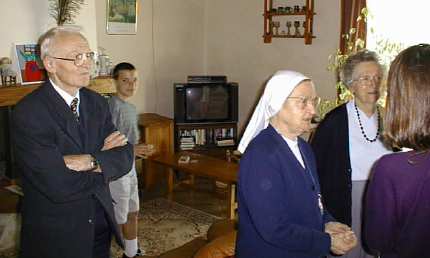
Sister Gabriel-Marie opens her album of photos for Allison Lastinger and
Jennifer Campbell. She is about to review her sixty years as a missionary and
teacher in equatorial Africa.
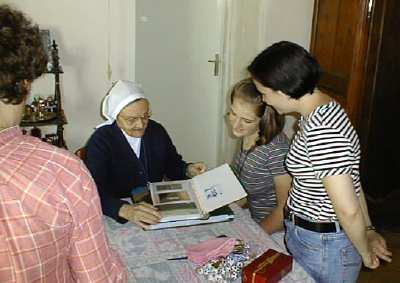
Among her more notable colleagues in Africa was Dr. Albert Schweitzer, with
whom she is pictured below. The photo is actually of a page from her dictionary of
Gisira-Ngosi, the language of the area in Gabon where she has worked most intensively.
(Soeur Gabriel-Marie Lemoine, Petit Dictionnaire Français-Gisira-Ngosi et éléments
de verbes , Congrégation Notre Dame de l'Immaculée-Conception, 1994).
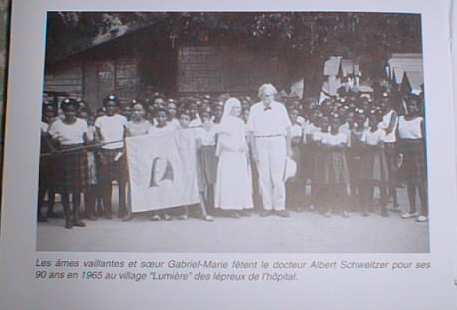
Below, Lucie Lastinger and all of us are fascinated with Sister Gabriel-Marie's
photos of life and wildlife in Africa. This is an especially important visit for all
of us, since Sister Gabriel-Marie says she will soon return permanently to the African
soil that has been her true home since she first left France over half a century ago.
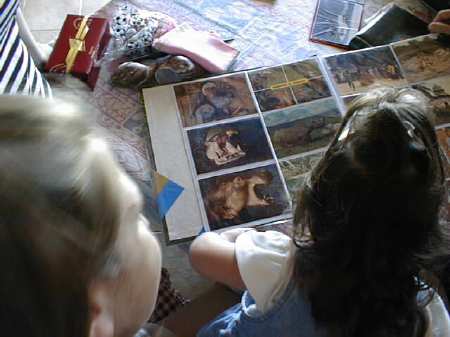
Below, Dr. Paul Lemoine discusses with his goddaughter the origins and
development of his early work on infant foetal alcohol syndrome, known by specialists in
France as "le syndrôme de Lemoine". As a pediatrician in post-war France,
Dr. Lemoine began to notice that children of chronically alcoholic women seemed to share
certain common traits of disfunction and disformity. He then published the first
scientific work in the world on the effects of alcohol on the unborn. Dr. Lemoine
then followed up on this initial research in the 1980's, when he tracked down the adults
he had observed as infants years earlier. What at first seemed an impossible task,
since all the original doctors had lost contact with their patients, turned out to be
painfully simple. Dr. Lemoine reversed course and, searching not where his subjects
began but where thought they would end up, was able to locate almost all of the original
babies in the asylums and sanitariums of Western France. The world now knows the
effects of alcohol abuse on those yet to join our world.
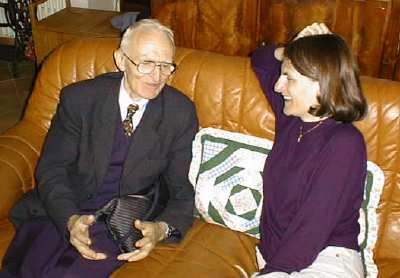
Stay tuned to WVU-V!
Go on to June 16, 1998.







